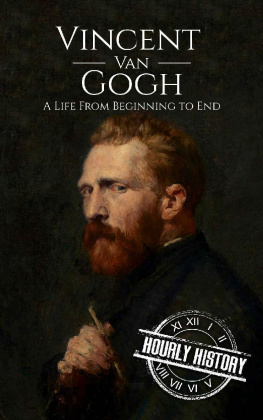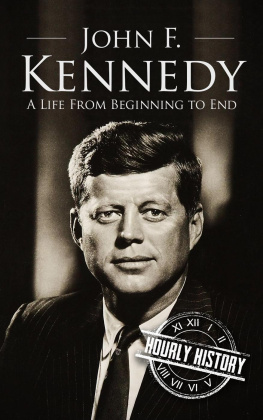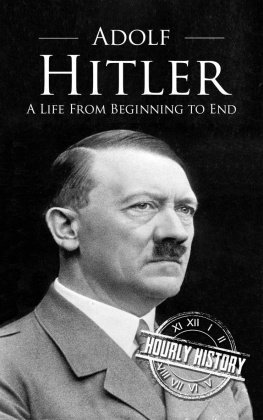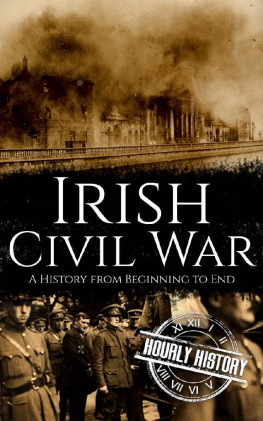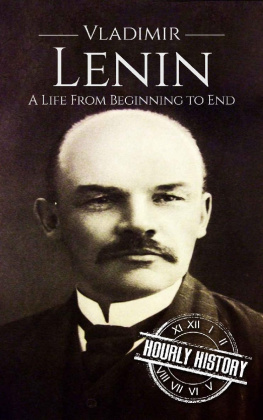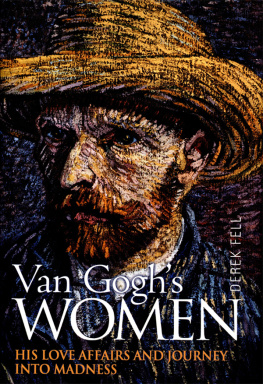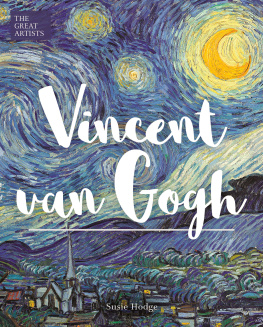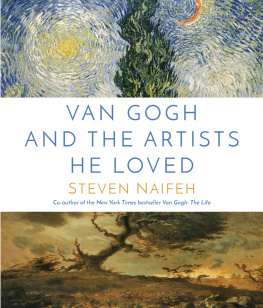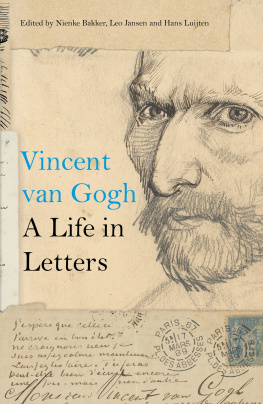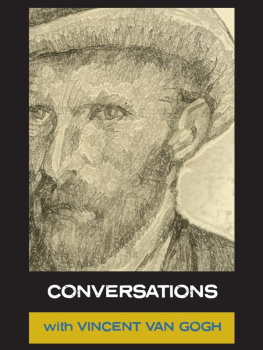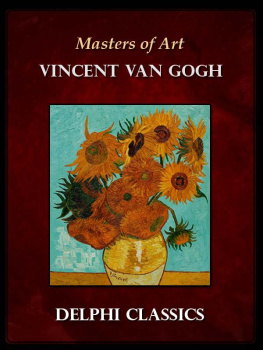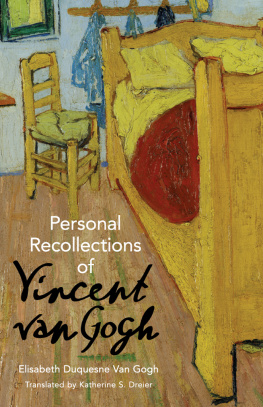VINCENT VAN GOGH
A Life From Beginning to End
Copyright 2018 by Hourly History.
All rights reserved.
Table of Contents
Introduction
Vincent Willem van Gogh is one of the most famous painters of all time. A solitary figure living in poverty, destroying himself to create the artworks that would not be appreciated until long after his death, van Gogh is the archetype of an artist. In van Gogh, the notion that a true artist must suffer for his art and that only the vulnerable can channel pure creativity takes form.
But van Goghs life story paints a different picture to the simple sketch of a starving man contemplating suicide that weve come to recognize. The desperate act he committed in 1889 when he severed his ear with a razor does not define him. Van Goghs life story is as complicated and as full of joy and sorrow as any other.
As a young man, van Gogh was convinced that he had experienced a religious calling and pursued a career in the church. But he was not a priest, he was an artist, and as soon as he realized this he took to his artistic training with the same fanaticism he had once channeled into studying the Bible.
In just ten years van Gogh painted more than 850 oil paintings and 1,300 drawings, watercolors, and studies. In the last few years of his life when his mental health was at its very worst, van Goghs productivity reached its peak, and he created some of his most accomplished and popular works.During a spell at the Saint-Remy asylum, van Gogh painted The Starry Nightone of the most recognizable paintings in the worldout of his bedroom window. And during an ill-fated collaboration with the artist Paul Gauguin that led to the incident with the razor, Vincent painted Bedroom in Arles and Gauguins Chair.
Van Gogh lived through debilitating mental illness and poverty, but his life was not lived in vain. While his last days were marred by isolation, he did not live or work in solitude and was very much a part of the European art scene. Van Gogh operated on the fringes of the Neo-Impressionist and Symbolist movements, ensuring his uniqueness but also making his work difficult to sell. Its a cruel twist that van Gogh died by his own hand in abject poverty while today his paintings are some of the most valuable in the world.
Chapter One
Vincent as a Boy
Someone has a great fire in his soul and nobody ever comes to warm themselves at it, and passers-by see nothing but a little smoke at the top of the chimney and then go on their way.
Vincent van Gogh
Vincent Willem van Gogh opened his eyes to the world on March 30, 1853, in the village of Groot Zundert in Brabant, the Netherlands. The future artist was born into a prosperous upper-middle-class family and was the sixth and eldest son of Protestant minister Theodorus van Gogh and his wife, Anna Carbentus. As you would assume, the van Goghs were a religious family and their parenting was strict. A governess educated young Vincent at home with his siblings until it was time for him to join the Zundert village school at age seven.
Vincent is often described as a serious child, an outsider, and a possible genius. These descriptors fit neatly into our perceptions of him as an adult, but its hard to say whether his early years were happy or not. As a very young child, Vincent was already developing a love for drawing. The van Gogh family also took long walks together in the countryside surrounding Zundert, instilling in him a deep connection to nature that he would spend much of his adult life trying to capture in oil paint.
Anna van Gogh was a disciplinarian, and Vincent later described his childhood as claustrophobic. Yet, when Vincent was given the opportunity to escape the van Gogh household in 1864 by joining a boarding school in Zevenbergen, he rebelled and begged his parents to bring him home. Instead, they sent Vincent, now aged 13, to a middle school closer to home in Tilburg. At Tilburg, the artist Constant Cornelius Huijsmans taught Vincent to capture the overall impression of objects rather than worrying too much about technique. Although Vincents interest was piqued, he was unhappy at Tilburg and dropped out before completing his studies.
At age 16, van Gogh entered the workplace. In his lettersthe most valuable primary source of the artists lifehe describes his childhood home life as austere and cold, and sterile. He was happy to leave it behind. Van Goghs first job was at The Hague, working as an apprentice at the Dutch arm of Parisian art dealer Goupil & Cie. He landed the job thanks to the influence of his uncle Cent, who also worked with Goupil & Cie.
Goupil & Cie dealt primarily in nineteenth-century French and Dutch paintings, and while van Gogh was completing his training, he was surrounded by etchings, paintings, and drawings by the most contemporary artists of the day. He became enamored with works by artists who collectively became known as School of The Hague and was influenced by the work of Josef Israels, Millet, Jacob Mavis, and Anton Mauve. Van Goghs younger brother, Theo, followed him into the art dealership business, and in 1873, he also began working for Goupil & Cie. Theo was sent to work in Brussels while Vincent was transferred to the London branch, and the brothers began an intense correspondence that would last until Vincents death.
Van Gogh thrived in London. Living in lodgings on Hackford Road in Stowell, he enjoyed his work and was making a good salary for a man who was only 20 years old. Yet his happiness was short-lived. Van Gogh experienced his first heartbreak in London when he became infatuated with his landladys daughter, Eugenie Loyer. Eugenie was, unbeknownst to anyone, already engaged and she firmly rejected Vincents advances. Meanwhile, his interest in the art market waned, and the companys decision to transfer him to Paris only served to increase his resentment towards the entire art market that turned artists passion into cold, hard cash. At the same time, van Gogh was experiencing something akin to a calling. Turning to religion for answers, he either resigned or was dismissed from Goupil & Cie in 1876 and decided to follow his fathers example by entering the church and becoming a minister.
Van Gogh briefly worked as a supply teacher in Ramsgate and then Middlesex, England before becoming the assistant to a Methodist minister named Jones. Although van Gogh was still in the very earliest stages of his religious education, Jones allowed him to give his first sermon a few months into their arrangement. A text of this sermon survives, and in it, van Gogh uses a painting to illuminate his explanation of life as a pilgrimage.
However, when van Gogh returned home to his family, who had since moved from Zundert to Etten, they were so worried about his physical and mental health that they insisted he would not return to England but stay with them instead. Van Gogh killed time for a few months by working in a bookshop in Dordrecht but could not shake the deep unhappiness hanging over him. In an attempt to escape the monotony of his life, he studied the Bible with extreme intensity and completely immersed himself in religious life. His habits became monastic, and he became completely frugal.
In 1877, van Goghs family sent him to live with his uncle, Johannes Stricker, in Amsterdam where he intended to study for the entrance exam to the Department of Theology. Stricker was a respected theologian, and under his care, van Gogh became even more religious. He used most of his spare time to translate the Bible into four different languages and fervently studied the practice of Christian confession. Around this time, van Gogh also began to teach himself to draw. Spending hours wandering the museums of Amsterdam, he began making sketches of what he saw but revealed in letters to Theo that he feared drawing would keep him from his religious work.

